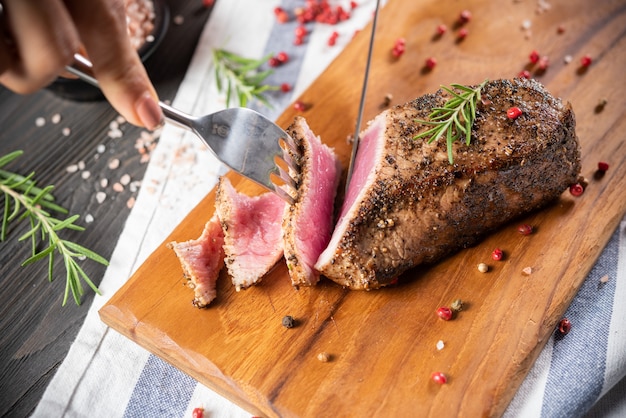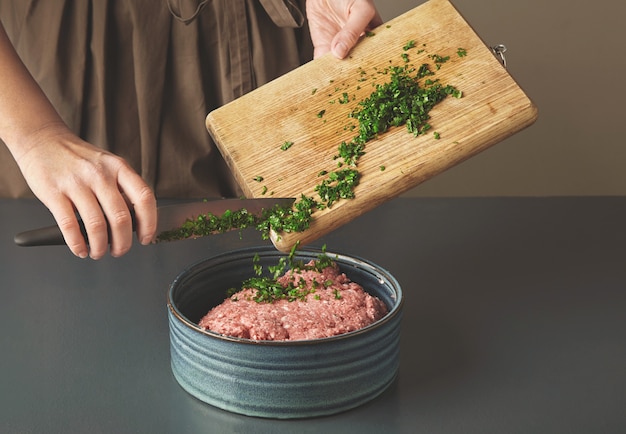Right, let's talk steak. But not just any steak, we're diving deep into the world of filet mignon. For years, I've been obsessed with mastering the perfect steak, and filet mignon has always held a special place in my heart. It's a classic for a reason - tender, juicy, and bursting with flavour. But let me tell you, it's taken me a while to get it right. You know the feeling - you pour your heart and soul into cooking a beautiful piece of meat, only to be left with a dry, chewy disappointment. It's enough to make you want to chuck the whole pan and order a pizza, isn't it? But fear not, fellow steak lovers! I've finally cracked the code, and I'm ready to share all my secrets with you. Get ready for a journey into the world of filet mignon, where we'll explore everything from choosing the perfect cut to mastering the art of searing and resting. Let's dive in, shall we?
Part 1: choosing the right cut

The Anatomy of a Filet Mignon
First things first, let's talk about the cut itself. You see, filet mignon is actually a fancy name for the tenderloin, a long, cylindrical muscle that runs along the backbone of the cow. It's the most tender cut of beef you can find, making it a favourite for special occasions. Now, the filet mignon is a specific section of this tenderloin, typically the smaller, thicker end, and it's often sold as a single, individual steak. Confused yet? Don't worry, it's all about the cut, and you'll find it labelled as "filet mignon" at the butcher's. Think of it as the crown jewel of the tenderloin.
Understanding the Grades
Alright, so now we know what to look for, but how do we choose the right filet? That's where the grading system comes in. In the UK, we use a system to grade beef based on its age, marbling, and overall quality. You'll see labels like "Standard," "Rump Steak," and "Prime" on your meat. Now, for a filet mignon, you definitely want to go for the best quality – "Prime" is the gold standard. This means the beef is from a younger animal, has more marbling (those beautiful streaks of fat that contribute to tenderness and flavour), and will be incredibly tender and juicy.
Why is marbling so important? Think of it like a built-in flavour enhancer. Those tiny veins of fat melt during cooking, adding richness and moisture to the meat. You'll notice a huge difference in flavour and texture between a well-marbled "Prime" filet mignon and a leaner, less marbled cut.
Buying the Right Size
Let's be honest, we all have different preferences when it comes to steak size. Some folks love a massive, thick cut, while others prefer a smaller, more manageable piece. There's no right or wrong answer here, it's all about personal taste. But remember, a thicker steak will take longer to cook, so keep that in mind when planning your meal. As a general rule, a 1.5-inch thick filet mignon is perfect for a satisfying, well-cooked steak. It allows for a nice sear on the outside and a perfectly cooked, juicy interior.
Part 2: Preparing the Steak

Getting Started: The Right Tools
Alright, we've got our beautiful filet mignon, now it's time to get cooking! Before we start, let's make sure we have the right tools for the job. You'll need a cast iron pan or a griddle, a meat thermometer, a sharp knife, and a good set of tongs. Don't worry if you don't have all the fancy gadgets, you can still cook a perfect steak with just a few essentials.
Seasoning and Marinade
Now, let's talk flavour. Filet mignon is naturally tender and juicy, but a good seasoning can really elevate it to the next level. Salt and pepper are the classic combination, and they're all you really need for a simple, delicious steak. But if you're feeling adventurous, you can add other herbs and spices like garlic powder, onion powder, paprika, or even a little bit of cayenne pepper for a kick.
A marinade can also be a fantastic way to add flavour and moisture to your steak. Just be sure to use a marinade that doesn't include acidic ingredients like lemon juice or vinegar, as these can toughen the meat. I like to marinate my filet mignon for a few hours in a mixture of olive oil, soy sauce, garlic, and fresh herbs. It's a simple but effective marinade that adds a ton of flavour.
Here's a quick tip: don't season your steak until right before you cook it. Salt draws out moisture from the meat, which can make it tougher. So, wait until the last minute to season your steak to ensure it stays juicy and flavorful.
Part 3: Cooking the Steak

Searing Perfection
Now we're getting to the fun part – the actual cooking! First, you'll want to sear your filet mignon to create a beautiful crust and lock in all those juicy flavours. Heat your cast iron pan or griddle over high heat until it's smoking hot. You can test the heat by adding a drop of water – if it sizzles immediately, you're ready to go. Now, add your filet mignon to the pan and sear for 1-2 minutes per side, making sure to cook it evenly. The goal is to achieve a nice brown crust without overcooking the inside. You can use a pair of tongs to gently lift the steak and make sure it's searing evenly on all sides.
Searing is all about creating that delicious Maillard reaction, a chemical process that happens when protein and sugars are exposed to high heat. This creates the beautiful browning and the rich, complex flavours that we all love in a perfectly cooked steak.
Choosing the Right Temperature
Alright, the steak is seared, now it's time to cook it to your desired temperature. This is where the meat thermometer comes in handy. Don't rely on your eyes alone – a thermometer will ensure your steak is cooked perfectly every time. Here's a quick guide to the different temperature ranges:
| Doneness | internal temperature (°C) |
|---|---|
| Rare | 46-49 |
| Medium-Rare | 52-55 |
| Medium | 57-63 |
| Medium-Well | 63-69 |
| Well-Done | 71-77 |
Personally, I prefer my filet mignon medium-rare, but it's all about taste. Once your steak reaches your desired temperature, remove it from the pan and let it rest for a few minutes. This will allow the juices to redistribute and prevent your steak from becoming dry.
Part 4: Resting and Serving
The Importance of Resting
You might be tempted to dive right into your perfectly cooked steak, but resist that urge! Resting is a crucial step that many people skip, and it can make all the difference in the tenderness and flavour of your meat. As the steak rests, the juices redistribute throughout the entire cut, creating a more even, tender, and juicy steak. Just place it on a cutting board and let it rest for 5-10 minutes before slicing and serving.
Serving with Style
The final touch! Now that your steak is rested and ready to go, it's time to choose the perfect accompaniments. For a classic combination, nothing beats mashed potatoes and a rich, creamy gravy. But you can also go for something lighter and fresher, like a simple green salad or roasted vegetables.
And don't forget the wine! A full-bodied red wine like Cabernet Sauvignon or Merlot pairs perfectly with filet mignon. The rich tannins in these wines complement the richness of the steak, creating a harmonious flavour profile.
Part 5: Beyond the Basics: Mastering the Griddle
The Art of Griddling
If you're looking to take your filet mignon game to the next level, a griddle is a fantastic tool. It allows for even cooking and beautiful grill marks, and it's perfect for feeding a crowd. To use a griddle, you'll want to heat it over medium-high heat for about 10 minutes. Then, add a little bit of oil and wait for it to shimmer before placing your filet mignon on the hot surface.
Griddling Techniques
Here are some tips for perfect griddling:
- Don't overcrowd the griddle. Give your steaks plenty of space to cook evenly. Overcrowding will lower the temperature and prevent the steaks from getting a good sear.
- Flip your steaks only once, when the bottom is nicely seared and you can easily slide a spatula underneath it. Flipping too often will interrupt the cooking process and prevent a good crust from forming.
- Don't press down on the steaks. Let them cook naturally. This will help prevent them from becoming tough. Using a spatula to press down on the steak will force out the juices and make it dry.
- Use a meat thermometer to check the internal temperature of your steaks and remove them from the heat when they reach your desired level of doneness. This is crucial for ensuring your steak is cooked perfectly to your liking.
With a little practice, you'll be a griddling master in no time!
Part 6: Filet Mignon Alternatives: Exploring Different Cuts
Beyond Filet Mignon
Let's face it, filet mignon can be pricey. If you're on a budget or just looking to explore other options, there are plenty of other cuts of beef that can be just as delicious and satisfying. Here are a few of my favourites:
sirloin steak
Sirloin steak is a great value-for-money option, and it's known for its rich flavour and good marbling. It's a more economical choice compared to filet mignon, but it can be a bit tougher. However, if you cook it properly, it can be just as tender and juicy. You can use a marinade to help tenderize the meat or try a longer, slower cooking method.
rib-eye steak
Rib-eye steak is a classic choice, and it's known for its melt-in-your-mouth tenderness and rich flavour. It's got a lot of marbling, which makes it super juicy, and it's perfect for grilling or pan-frying. It's a great alternative to filet mignon if you want a more robust flavour profile.
new york strip Steak
New York strip steak is a leaner cut of beef, but it's still incredibly flavorful. It's got a nice, even texture and it's perfect for those who prefer a slightly chewier steak. It's a good choice for those who want a steak with a bit more "bite" to it.
Part 7: cooking tips and Tricks
Tips from a seasoned chef
Alright, now that we've covered the basics, let's delve into some of my favourite tips and tricks for cooking the perfect filet mignon:
- Don't be afraid to use a little butter. A pat of butter added to the pan right before you remove the steak will add a touch of richness and flavour. It also helps create a beautiful, glossy finish.
- Let your steak rest on a cutting board after cooking. This will allow the juices to redistribute and prevent the steak from becoming dry. This is essential for ensuring a juicy and tender steak.
- Don't overcook your steak. Overcooking is the most common mistake people make when cooking filet mignon. Overcooked steak becomes dry and tough. Use a meat thermometer to ensure your steak is cooked to your desired temperature.
- Don't be afraid to experiment. There are so many different ways to cook and season filet mignon. Get creative and find what you like best. Try different marinades, spices, and cooking methods to discover your perfect steak.
Part 8: Filet Mignon FAQs
You've got questions, I've got answers! Here are some of the most common questions I get about filet mignon:
What is the best way to cook filet mignon?
The best way to cook filet mignon is to sear it over high heat and then finish cooking it in the oven. This will ensure that the steak is cooked evenly and has a beautiful crust. You can also cook filet mignon on the grill, but be careful not to overcook it. The grill method gives a beautiful char and smoky flavour.
How long should I cook filet mignon?
The cooking time for filet mignon will vary depending on the thickness of the steak and the desired level of doneness. As a general rule, a 1.5-inch thick filet mignon should be cooked for about 4-5 minutes per side for medium-rare. Use a meat thermometer to ensure the steak is cooked to your desired temperature.
What are the best sides to serve with filet mignon?
There are many delicious sides that pair well with filet mignon, but some classics include mashed potatoes, roasted vegetables, asparagus, and a green salad. You can also serve filet mignon with a rich, creamy sauce, like a Béarnaise or a mushroom sauce.
What is the difference between filet mignon and tenderloin?
Filet mignon is actually a specific cut of tenderloin. It is the smaller, thicker end of the tenderloin, and it's often sold as a single, individual steak. The rest of the tenderloin can be used to create other cuts, like tenderloin medallions or chateaubriand.
Can I freeze filet mignon?
Yes, you can freeze filet mignon. To freeze it properly, wrap it tightly in plastic wrap and then place it in a freezer-safe bag. It can be frozen for up to 3 months. When you're ready to use it, thaw it in the refrigerator overnight.
Part 9: filet mignon recipes
Ready to put your new knowledge into practice? Here are a few of my favourite filet mignon recipes that are sure to impress your guests:
Classic Filet Mignon with Béarnaise Sauce
This recipe is a classic for a reason. It's simple, elegant, and absolutely delicious.
- Ingredients:
- 1 (1.5-inch thick) filet mignon steak
- Salt and pepper to taste
- 1 tablespoon olive oil
- 1/4 cup Béarnaise sauce (store-bought or homemade)
Instructions:
- Preheat oven to 200°C.
- Season the filet mignon with salt and pepper.
- Heat the olive oil in a large oven-safe skillet over high heat.
- Sear the filet mignon for 1-2 minutes per side, until it is nicely browned.
- Transfer the skillet to the oven and cook for 5-7 minutes, or until the steak reaches your desired level of doneness.
- Remove the skillet from the oven and let the steak rest for 5-10 minutes before slicing and serving.
- Top with the Béarnaise sauce and enjoy!
grilled filet mignon with Garlic Herb Butter
This recipe is perfect for grilling season. The garlic herb butter adds a delicious flavour to the steak.
- Ingredients:
- 1 (1.5-inch thick) filet mignon steak
- Salt and pepper to taste
- 1/4 cup butter, softened
- 2 cloves garlic, minced
- 1 tablespoon chopped fresh parsley
- 1 tablespoon chopped fresh thyme
Instructions:
- Preheat grill to medium-high heat.
- Season the filet mignon with salt and pepper.
- In a small bowl, combine the butter, garlic, parsley, and thyme.
- Place the filet mignon on the grill and cook for 4-5 minutes per side, or until it reaches your desired level of doneness.
- Remove the steak from the grill and top with the garlic herb butter.
- Let the steak rest for 5-10 minutes before slicing and serving.
Part 10: Final Thoughts
There you have it, my comprehensive guide to cooking the perfect filet mignon. From choosing the right cut to mastering the art of searing and resting, I've shared all my secrets with you. Remember, the key to success is to choose high-quality meat, cook it evenly, and let it rest before serving. So go forth and conquer the world of steak!
And remember, don't be afraid to experiment. There are so many different ways to cook and season filet mignon. Find what you like best and enjoy!
Everyone is watching

Corn on the Cob: The Ultimate Guide to Perfectly Cooked Ears
Healthy MealsAh, corn on the cob. Just the name evokes images of sunny days, barbecues, and that sweet, juicy flavour that ...

Perfect Pork Roast Oven Cooking Time: A Guide to Delicious Results
Healthy MealsThere's something truly satisfying about a perfectly roasted pork. The aroma alone is enough to make your mout...

Ham Cooking Time: How Long to Bake, Smoke, or Boil a Delicious Ham
Healthy MealsAh, ham. It's a classic, isn't it? A real crowd-pleaser, especially around holidays. And when done right, it'...

Scallops: The Ultimate Guide to Perfect Cooking
Healthy MealsAh, scallops. Those delicate, sweet, and utterly delicious morsels of the sea. They hold a special place in my...

Spaghetti Squash: The Ultimate Guide to Cooking and Serving
Healthy MealsRemember that time you saw spaghetti squash at the supermarket, looking all bumpy and strange, and thought, "W...
